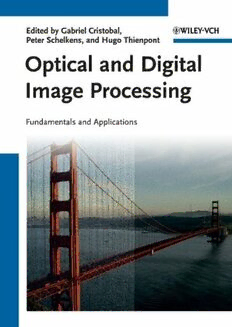
Optical and Digital Image Processing PDF
Preview Optical and Digital Image Processing
Editedby GabrielCristo´bal,PeterSchelkens, andHugoThienpont OpticalandDigitalImageProcessing Related Titles Ackermann,G.K.,Eichler,J. Acharya,T.,Ray,A.K. Holography ImageProcessing APracticalApproach PrinciplesandApplications 2007 2005 E-Book ISBN:978-3-527-40663-0 ISBN:978-0-471-74578-5 Ersoy,O.K. Singer,W.,Totzeck,M.,Gross,H. Diffraction, FourierOptics and HandbookofOptical Systems Imaging Volume2:PhysicalImageFormation 2006 2005 ISBN:978-0-471-23816-4 ISBN:978-3-527-40378-3 Edited by Gabriel Cristo´bal, Peter Schelkens, and Hugo Thienpont Optical and Digital Image Processing Fundamentals and Applications TheEditors AllbookspublishedbyWiley-VCHare carefullyproduced.Nevertheless,authors, Dr.GabrielCristo´bal editors,andpublisherdonotwarrantthe InstitutodeOptica(CSIS) informationcontainedinthesebooks, ImagingandVisionDept. includingthisbook,tobefreeoferrors. Serrano121 Readersareadvisedtokeepinmindthat 28006Madrid statements,data,illustrations,procedural Spain detailsorotheritemsmayinadvertentlybe inaccurate. Prof.Dr.PeterSchelkens VrijeUniversiteitBrussel LibraryofCongressCardNo.:appliedfor DepartmentofElectronicsand Informatics(ETRO) BritishLibraryCataloguing-in-Publication Pleinlaan2 Data 1050Brussels Acataloguerecordforthisbookisavailable Belgium fromtheBritishLibrary. Prof.HugoThienpont Bibliographicinformationpublishedbythe VrijeUniversiteitBrussel DeutscheNationalbibliothek BrusselsPhotonicsTeam(B-PHOT) TheDeutscheNationalbibliothek Pleinlaan2 liststhispublicationintheDeutsche 1050Brussels Nationalbibliografie;detailedbibliographic Belgium dataareavailableontheInternetat <http://dnb.d-nb.de>. 2011WILEY-VCHVerlagGmbH&Co. KGaA,Boschstraße.12,69469Weinheim Allrightsreserved(includingthoseof translationintootherlanguages).Nopart ofthisbookmaybereproducedinany form–byphotoprinting,microfilm,orany othermeans–nortransmittedortranslated intoamachinelanguagewithoutwritten permissionfromthepublishers.Registered names,trademarks,etc.usedinthisbook, evenwhennotspecificallymarkedassuch, arenottobeconsideredunprotectedbylaw. ThecopyrightfortheMatlabandother softwarecodesprintedinthisbookremains withtheauthor. Composition LaserwordsPrivateLtd., Chennai,India PrintingandBinding betz-druckGmbH, Darmstadt CoverDesign AdamDesign,Weinheim PrintedinSingapore Printedonacid-freepaper ISBN:978-3-527-40956-3 V Foreword OpticalandDigitalImageProcessing Thereisatendencythesedaysforscientistsandengineerstobehighlyspecialized. It is therefore a pleasure to see a book covering a truly broad set of topics. Granted that all the topics relate in one way or another to the field of optics, broadlyinterpreted;however,withinthatbroadcategory,thisbookcertainlycovers abreadthofsubjects. The first element of breadth lies in the joint coverage of both optical signal processinganddigitalsignalprocessing.Infact,manymodernsignalprocessing systems depend on both optics and digital technologies. Images are usually the entitytobeprocessed,andmostoftentheseimagesareformedbyopticalsystems. Themethodsforprocessingsuchimagesarenumerousanddiverse,dependingin largepartupontheapplication. At one time, optical analog processing held sway as the fastest method for performinglinearoperationson2Dsignals,buttherelentlessprogressindigital processing, a consequence of Moore’s law, has displaced optical processing in many applications. However, the most interesting and complex optical systems often entail some optical preprocessing followed by digital manipulation. Good examples are found in the field of adaptive optics, in which optical methods for wavefront sensing are followed by digital methods for determining appropriate changesforanadaptivemirror. The subject matter covered in this book ranges over many topics, which can bebroadlyclassifiedasfollows:(i)fundamentalsofbothopticsanddigitalsignal processing;(ii)opticalimaging,includingmicroscopyandholography;(iii)image processingincludingcompression,deconvolution,encryption,andpatternrecog- nition; (iv) signal representation, including time-frequency, spline, and wavelet representations; and (v) miscellaneous applications, including medical imaging anddisplays.Theauthorsaredrawninternationally,thusallowingawindowinto theresearchinterestsofscientistsandengineersinmanycountries. Asmentionedabove,itisrefreshingtoseesuchbreadthunderonecover.This bookshouldprovide interesting and informative reading to those wishing to see VI Foreword thebroadpictureofimageprocessinganditsapplicationsthroughaninternational lens. JosephW.Goodman VII Contents Preface XXIX ListofContributors XXXIX ColorPlates LI 1 FundamentalsofOptics 1 Ting-ChungPoonandJung-PingLiu 1.1 Introduction 1 1.2 TheElectromagneticSpectrum 1 1.3 GeometricalOptics 3 1.3.1 RayTransferMatrix 3 1.3.2 Two-LensImagingSystem 6 1.3.3 Aberrations 8 1.4 Maxwell’sEquationsandtheWaveEquation 9 1.5 WaveOpticsandDiffraction 11 1.6 FourierOpticsandApplications 14 1.6.1 IdealThinLensasOpticalFourierTransformer 14 1.6.2 ImagingandOpticalImageProcessing 17 1.6.3 OpticalCorrelator 19 1.7 TheHumanVisualSystem 21 1.8 Conclusion 23 References 23 2 FundamentalsofPhotonics 25 ErikStijnsandHugoThienpont 2.1 Introduction 25 2.2 InterferenceandDiffraction 25 2.2.1 Interference 25 2.2.2 Diffraction 26 2.2.2.1 DiffractionataOne-DimensionalSlit 26 2.2.2.2 DiffractionataCircularAperture 27 2.2.3 Resolution 28 2.2.3.1 AngularResolution 28 2.2.3.2 SpatialResolution 29 VIII Contents 2.2.4 Coherence 29 2.2.4.1 TemporalorLongitudinalCoherence 29 2.2.4.2 TransverseorSpatialCoherence 30 2.3 TermsandUnits:TheMeasurementofLight 30 2.3.1 Introduction:RadiometryversusPhotometry 30 2.3.2 RadiometricTermsandUnits 30 2.3.2.1 RadiantEnergy 30 2.3.2.2 RadiantFlux 31 2.3.2.3 RadiantFluxDensity 31 2.3.2.4 RadiantIntensity 31 2.3.2.5 Radiance 32 2.3.2.6 RadiantExposure 32 2.3.3 PhotometricTerms 33 2.3.3.1 SpectralTerms 33 2.3.3.2 SpectralSensitivityoftheEye 33 2.3.3.3 LuminousTerms 33 2.3.4 PhotometricUnits 34 2.3.4.1 OtherVisualTermsandUnits 34 2.4 Color 35 2.4.1 Introduction 35 2.4.2 TheSpectrumofLight 36 2.4.3 TristimulusTheory 36 2.4.3.1 TheTristimulus 36 2.4.3.2 The1931CIEStandard 38 2.4.3.3 CIE1976UCSDiagram 39 2.4.4 TheoryoftheOpponentColors 40 2.4.4.1 DescribingtheVisualObservations 40 2.4.4.2 SaturationorChroma 41 2.4.4.3 Hue 41 2.4.4.4 TheCIELABDiagram 42 2.5 BasicLaserPhysics 43 2.5.1 Introduction 43 2.5.2 NormalorSpontaneousEmissionofLight 43 2.5.3 Absorption 44 2.5.4 StimulatedEmissionofLight 44 2.5.5 Amplification 45 2.5.6 BasicSetup 45 2.6 BasicPropertiesofLaserLight 46 2.6.1 LaserLightHasOneDirection 47 2.6.2 LaserLightIsMonochromatic 47 2.6.3 LaserLightIsCoherent 47 2.6.4 LaserLightIsIntense 47 2.7 Conclusions 48 References 48 Contents IX 3 BasicsofInformationTheory 49 MichalDobes 3.1 Introduction 49 3.2 Probability 49 3.2.1 SeveralEvents 50 3.2.2 ConditionalProbabilities:IndependentandDependent Events 51 3.2.3 RandomVariable 52 3.2.4 DistributionFunction 52 3.2.5 DiscreteDistribution 53 3.2.6 ContinuousDistribution 53 3.2.7 ExpectedValue 54 3.3 EntropyandMutualInformation 54 3.3.1 HistoricalNotes 55 3.3.2 Entropy 55 3.3.2.1 SomePropertiesofEntropy 55 3.3.3 JointEntropy 56 3.3.4 MutualInformation 60 3.3.5 Kullback–LeiblerDivergence 62 3.3.6 OtherTypesofEntropies 62 3.4 InformationChannel 62 3.4.1 DiscreteChannel 63 3.4.2 ChannelCapacity 63 3.4.3 SymmetricChannel 64 3.4.4 BinarySymmetricChannel 65 3.4.5 GaussianChannel 65 3.5 Conclusion 66 Appendix3.A:ApplicationofMutualInformation 67 References 68 4 FundamentalsofImageProcessing 71 VaclavHlavac 4.1 Introduction 71 4.2 DigitalImageRepresentation 73 4.2.1 TopologicalandMetricPropertiesofImages 74 4.2.2 BrightnessHistogram 77 4.3 ImageFilteringParadigm 78 4.4 FrequencyDomain 80 4.4.1 1DFourierTransform 80 4.4.2 2DFourierTransform 85 4.5 FilteringintheImageDomain 90 4.6 Conclusions 96 References 96 X Contents 5 JointSpatial/Spatial-FrequencyRepresentations 97 GabrielCristo´bal,SalvadorGabarda,andLeonCohen 5.1 Introduction 97 5.2 FundamentalsofJointRepresentations 98 5.2.1 Notation 99 5.2.2 TheWignerDistribution 100 5.2.2.1 Marginals 101 5.2.2.2 Inversion 101 5.2.2.3 TranslationInvariance 101 5.2.2.4 ProductofImages 102 5.2.2.5 OverlapofTwoImages 102 5.2.2.6 RealImages 102 5.2.2.7 CrossWignerDistribution 103 5.3 OtherDistributions 103 5.3.1 TheSpectrogram 104 5.3.2 TheAnalyticImage 104 5.4 ThePseudo-Wigner–VilleDistribution(PWVD) 105 5.4.1 1D-SmoothedPWVD 105 5.4.2 1DDirectionalPWVD 105 5.4.3 2D-SmoothedPWVDDefinitionandImplementation 108 5.5 2DLog-GaborFilteringSchemesforImageProcessing 110 5.6 TextureSegmentation 112 5.7 HybridOptical–DigitalImplementation 114 5.8 Conclusions 116 Acknowledgments 116 References 116 6 SplinesinBiomedicalImageProcessing 119 SlavicaJonicandCarlosOscarSanchezSorzano 6.1 Introduction 119 6.2 MainTheoreticalResultsaboutSplines 120 6.2.1 SplinesasInterpolantsandBasisFunctions 120 6.2.1.1 TensorProductSplines 120 6.2.1.2 PolyharmonicSplines 127 6.2.2 SplinesforMultiscaleAnalysis 129 6.3 SplinesinBiomedicalImageandVolumeRegistration 131 6.4 Conclusions 132 References 133 7 Wavelets 135 AnnDoomsandIngridDaubechies 7.1 Introduction 135 7.2 ChasingSherlockHolmes:HowtoScrutinizeanImage 139 7.2.1 ClassicalFourierAnalysis 140 7.2.2 ForcesofNature 141
